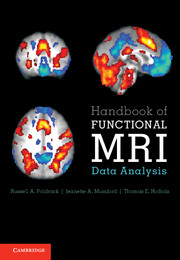Book contents
- Frontmatter
- Contents
- Preface
- 1 Introduction
- 2 Image processing basics
- 3 Preprocessing fMRI data
- 4 Spatial normalization
- 5 Statistical modeling: Single subject analysis
- 6 Statistical modeling: Group analysis
- 7 Statistical inference on images
- 8 Modeling brain connectivity
- 9 Multivoxel pattern analysis and machine learning
- 10 Visualizing, localizing, and reporting fMRI data
- Appendix A A Review of the General Linear Model
- Appendix B Data organization and management
- Appendix C Image formats
- Bibliography
- Index
Appendix B - Data organization and management
Published online by Cambridge University Press: 01 June 2011
- Frontmatter
- Contents
- Preface
- 1 Introduction
- 2 Image processing basics
- 3 Preprocessing fMRI data
- 4 Spatial normalization
- 5 Statistical modeling: Single subject analysis
- 6 Statistical modeling: Group analysis
- 7 Statistical inference on images
- 8 Modeling brain connectivity
- 9 Multivoxel pattern analysis and machine learning
- 10 Visualizing, localizing, and reporting fMRI data
- Appendix A A Review of the General Linear Model
- Appendix B Data organization and management
- Appendix C Image formats
- Bibliography
- Index
Summary
The amount of computation that is performed, and data that are produced, in the process of fMRI research can be quite astounding. For a laboratory with multiple researchers, it becomes critical to ensure that a common scheme is used to organize the data; for example, when a student leaves a laboratory, the PI may still need to determine which data were used for a particular analysis reported in a paper in order to perform additional analyses. In this appendix, we discuss some practices that help researchers meet the computational needs of fMRI research and keep the data deluge under control, particularly as they move toward developing a research group or laboratory with multiple researchers performing data analysis.
Computing for fMRI analysis
The power of today's computers means that almost all of the data analysis methods discussed in this book can be performed on a standard desktop machine. Given this, one model for organization of a laboratory is what we might call “just a bunch of workstations” (JBOW). Under this model, each member of the research group has his or her own workstation on which to perform analyses. This model has the benefit of requiring little in the way of specialized hardware, system administration, or user training. Thus, one can get started very quickly with analysis.
- Type
- Chapter
- Information
- Handbook of Functional MRI Data Analysis , pp. 201 - 207Publisher: Cambridge University PressPrint publication year: 2011



